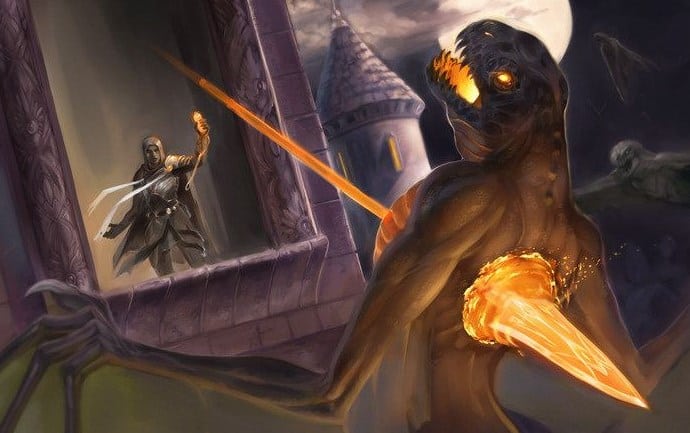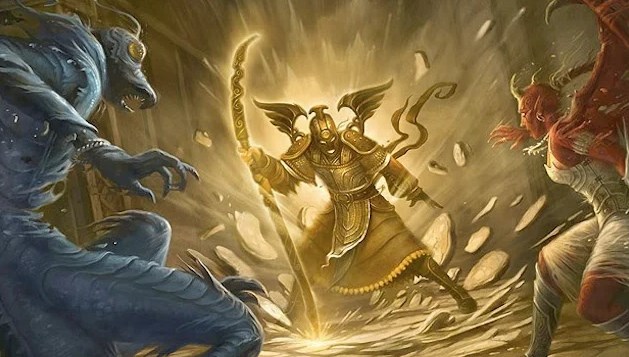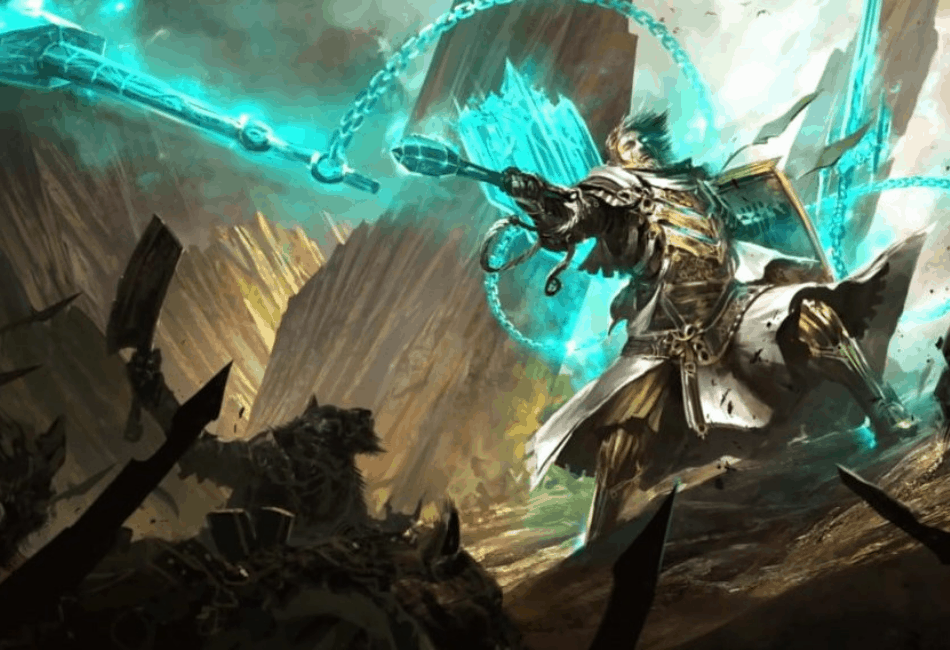You’re walking around the big city and stumble upon a group of people beating out a woman in an alley. You enter calmly and shout, “Sinners, stop this at once, or may your souls found peace by the hand of Eldath.” The muggers see you with a vicious grin and let the woman on the ground, bleeding. “And what if we make the same to you, holy lady. Let us see what’s under that pacifist robe of yours.”
The woman on the floor feels a rush of life through his body as she opens her eyes to see your face close to hers. Behind you, a big spectral hand is slapping the muggers to the walls of the alley. You stand straight and see the burglars being slapped until they pass out. While the hand keeps hitting, you clean the woman with magic, help her stand up, and accompany her out the alley with a smile. Welcome to our Spiritual Weapon 5e Guide.
What is it?

As stated in the PHB (Player’s Handbook) Spiritual Weapon is a 2nd level spell. The casting time is one bonus action, the range is 60 feet, and the duration is 1 minute. The Components are Verbal, Somatic. The effect reads as follows:
“You create a floating, spectral weapon within range that lasts for the duration or until you cast this spell again. When you cast the spell, you can make a melee spell attack against a creature within 5 feet of the weapon. On a hit, the target takes force damage equal to 1d8 + your spellcasting ability modifier.
As a bonus action on your turn, you can move the weapon up to 20 feet and repeat the attack against a creature within 5 feet of it.
The weapon can take whatever form you choose. Clerics of deities who are associated with a particular weapon (as St. Cuthbert is known for his mace and Thor for his hammer) make this spell’s effect resemble that weapon.”
The spell’s damage increases by 1d8 for every two slots above the second.
Breaking down the spell’s characteristics

First, this is a 2nd level D&D spell, which means that it will come into play around 3rd level for full casters that have it available. At these levels, we have spells like Enhance Ability, Aid, or Hold Person. With just a glance over these, we could say that Spiritual Weapon won’t have such a prominent effect in a single encounter as hold person, but it will be a reliable way of dishing out damage in every encounter.
It is an evocation spell, that is, a spell of pure energy used to destroy enemies, and destroy it does.
Now is the time for the real potential of this spell to shine, his action economy. The spiritual weapon works with Bonus Action when cast and for later use. This simple fact makes it an excellent go-to attack for the bonus action. Just cast this spell in the first turn with a cantrip, and then, in subsequent turns, you can be throwing powerful spells with your action and deal 1d8+Wis every turn with virtually no cost.
The range is 60 feet, just good enough. You would probably use some other spells or weapons to attack from long range or to attack flying creatures. Nonetheless, this range grants you the possibility of attacking almost anyone inside a room and grants you an attack that would probably be farther than the movement of the creature you’re attacking. Also, this spiritual weapon can move 20 feet per turn, making this range theoretically higher.
The components are verbal and somatic, which means that you can cast it with nothing in hand, but keep in mind that you can’t cast it when restrained.
Now is the second great attribute about Spiritual Weapon. A one-minute duration is ten turns of combat, probably more than you’d normally need, but the real bomb is that it’s concentration-free. Just let this fact sink in. No concentration is really powerful for a stacking damage spell. You can lock a creature inside a wall of force and smack him with this spell all alone. You can pair it with all the good concentration-based control spells for an entire minute.
Breaking down the spell’s effect

First, we’ll look at the spell’s damage: 1d8 + ability modifier, considering a +3 Wisdom for a Cleric, gives us an average of 7,5 force damage per hit. This alone is not much, but we have to take into account that we have ten turns of bonus actions to keep attacking. It gives us a total damage output of 110. That alone is great, but the flexibility of making several attacks to different targets during combat with no downside makes it just awesome.
Besides the raw output, the type of damage is force, which is the least resisted of the game. The only creature that has immunity to it is the Helmed Horror, and little else can reduce this damage by any means. Not only that, but remember that the weapon makes a spell attack, which means that it can crit, so double that output.
We can derive some other characteristics from the spiritual weapon, looking at what it doesn’t specify. Jeremy Crawford said in a tweet that “Some spells are drawn to or harm only the life force of creatures.” This spell theoretically couldn’t harm objects; that is why it specifies “melee spell attack against a creature.
” It’s a “spiritual” weapon; it is meant to do damage to living things. Does that mean that it does not damage constructs or undead? Good question. The answer? Well, yes, but the DM could make an exception in his world, always telling players in advance for those technical differences.
Ideas for flavorful killing
Last but not least, how does this weapon look? Well, this is the flavor of the spell you choose. The description specifies that if the deity has a signature weapon, then the spell takes that form. For example, the Hammer of Thor. Even if that’s the case, you should make the weapon appear as it best suits your character.
Not every hammer is the same. You could have a humongous hammer the size of a person or a simple and realistic Warhammer flying around. You could say that it’s a bow that, instead of moving 20 feet, launches a projectile and rematerializes where it lands. There’s no limit, and no option is better than another.
Some things to keep in mind that may help you give some flavor to your Spiritual Weapon are your race and lineage; a dwarven sword is not the same as an elven one; a dwarven spirit may be a lot rougher than a gnome. Your class or subclass, a war cleric may want a halberd, whereas a Divine Soul sorcerer could simply use some kind of phantasmal force.
Your character’s sentiments, it’s possible to give color to this spell, so you could have a color code of sentiments to your weapon; when angry, it’s a red spear, when excited is a green maul, so on and so forth.
Who is worthy enough?

All very well, but how can I get my hands in this damaging spell? Well, first, as we’ve said, this spell is found in the Cleric Spells list, so every Cleric could use it at the 3rd level. Furthermore, there are some Cleric Dominions who have it always prepared to use (remember that clerics have access to all his spells to prepare when they finish a long rest), those being the War and the Life Domain Clerics.
There is also the Bard, who has the Magical Secrets ability at tenth level, allowing them to pick any spell from any class. This is probably best used to choose a higher-level spell, but the College of Lore Bard can make this choice at 6th level, allowing him to grab lower-level spells with less opportunity cost. If you have a front liner bard with good dexterity, this spell could up your damage quite a bit.
One awesome way to pick “Spiritual Weapon” comes with the Oath of Conquest Paladin, who has this spell as part of his oath spell list. One of the downsides is that this comes online at 5th level, two levels after the clerics would have gotten it. The other downside is that Paladins already have a lot of things competing with his bonus action, and at the same time, they have fewer spell slots. Nonetheless, giving a Paladin this kind of offensive tool, first, gives them a ranged attack (which they often lack), and also, it’s still an increasing of 1d8 + spellcasting mod per attack to an already front line damaging bomb that are the paladins.
Last but not least, the Divine Soul Sorcerers have access to the Cleric Spell list, which is always a good thing. In this case, the sorcerer now has a great spell for his bonus action earlier than most of his other subclasses, which don’t have a damage-dealing bonus action spell until level 5. Also, this spell grants a possibility to enter a fight a little closer to the enemy, although this probably won’t be great for a Sorcerer.
Now for DMs, these are the monsters that have Spiritual Weapon: Kuo Toa Archpriest, Mummy Lord, Orc Eye of Gruumsh, Sahuagin Priestess, Choldrith, Drow Inquisitor, and Drow Matron Mother. We can see that most of these monsters represent some kind of religious authority to their cultures, so you could give this spell to other monsters that have that characteristic. This spell will grant these monsters some action economy boost, great for solo fights.
Then, there are the NPC sheets that grant this spell: Priest, Cult Fanatic and War Priest. All of which also follow the “religious authority” characteristic. In these cases, the DM can also play with the “favored weapon” of the god to give these NPCs some flavor in combat.
FAQ
Question: Can you Interact With Spiritual Weapon 5e?
Answer: The spell’s description doesn’t give any way of interacting with the spiritual weapon other than being moved by the caster and hitting creatures. Furthermore, there’s a tweet of Jeremy Crawford that says, “A spiritual weapon doesn’t pass through walls. It also doesn’t occupy its space; it’s not a creature, and it’s not described as being large enough to fill its space.” In other words, it’s not meant to do anything other than destroy foes.
Question: Can you Destroy a Spiritual Weapon 5e?
Answer: The spell says that the weapon “lasts for the duration or until you cast this spell again”; therefore, the weapon can’t be ended with anything but a “Dispel Magic” spell. Also, the spell is a non-concentration one, so even if the caster dies, the spiritual weapon could remain there until the duration ends.
Question: Does Spiritual Weapon Deal Magic Damage?
Answer: No, a Spiritual Weapon is a spell that specifies the type of damage that it does. In this case, it is force damage. Also, the weapon says that it targets creatures, no objects, so it doesn’t function as a normal weapon.
In Conclusion: Is this Smacking Good Enough?
Is “Spiritual Weapon” worth picking? Well, hell yeah. As said before, you can’t go wrong with having extra damage all rounds and with almost no cost. This spell grants any cleric a powerful attack to rival their martial companions while also leaving their action free to cure his allies. Also, concentration-free is just amazing. Pair this spell with Hold Person, Spirit Guardians, Insect Plague, and the list goes on.
There is really no downside with these spells; it even stays up when you go down. So if you get up again, you don’t need to recast it. The only thing that may be a little tricky is the speed of 20 feet. Most creatures could just outrun it with ease if they need to. Also, this spell is probably better the longer the battle. A two-round fight could make this spell seem a little lackluster. But that is about it. Have fun smacking with this incredible spell.
- Shadow Blade 5e Guide: The Edgy Sword - October 31, 2022
- Aid 5e Guide: Free Points! - October 1, 2022
- Flaming Sphere 5e Guide: Running Orb of Fiery Chaos: - October 1, 2022

